Introduction: KAYU AND LUCIE FONTAINE
After a few years of living on the island of Bali, I started to feel the need to connect with the international contemporary art discourse. I wanted to create a reality similar to the dream of the character Fitzcarraldo from one of Werner Herzog’s films: an opera theatre inside the jungle. I was curious to see contemporary artworks displayed in a different context and how the new context could affect the art. I wanted the new context to be similar to an ‘altrove’ (elsewhere), in the middle of nowhere surrounded by nature, a place between magic and dreams in complete opposition to the usual white cube gallery and the environment that surrounds it. It was my personal project for quite some time, but I had always felt that there was something missing, so it had been in a state of incubation for quite a while. An encounter with one of Lucie Fontaine’s employees provided the spark that brought Kayu (an Indonesian word which means ‘wood’) into being.
Lucie Fontaine* gave me the possibility to connect Bali with the international intellectual scene, introducing me to amazing artists colleagues and giving the project the professional aura that distinguishes her work by including Kayu as her Balinese branch. Although it is far from being in the jungle, Kayu was born within the Balinese natural world and hosted in an unusual building, an antique Joglo, an old Javanese wooden house inside a Balinese/Javanese traditional complex, Setia Darma The House of Masks and Puppets, which aims to preserve Indonesian traditional culture by showing one of the biggest collections of masks and puppets in Indonesia. This new environment gave me the inspiration to create a programme of events at Kayu. The intimacy of the place, the fact that the place is the house for the masks, the nature, the exotic environment, are all elements that later influenced my direction of which artists to invite.
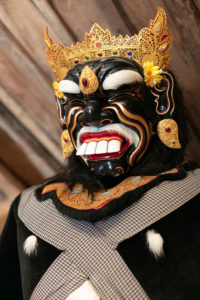
Mask, Setia Darma The House of Masks and Puppets, Bali, 2018. Courtesy of BIASA. Photo: Cyril Saulnier.
Kayu became a platform to support the growth and awareness of an international contemporary art discourse in Bali through experimental and conceptual projects. By continuously facilitating artistic activities and operating as an incubation facility, it provides opportunities for information and knowledge exchange between Bali, Indonesia and the external art world. Since the inaugural project ‘Domesticity V’ in 2014, Kayu has been developing projects with contemporary artists such as Michelangelo Pistoletto, Rirkrit Tiravanija, Anthea Hamilton, Dora Budor, Arahmaiani, Maria Hassabi, Mierle Laderman Ukeles, Melati Suryodarmo, Claire Fontaine, Corrado Levi, Jessica Warboys, Agnieszka Kurant, Michael Helfman, Miri Segal, Ciprian Mureşan, Lina Viste Grønli, Lupo Borgonovo, Entang Wiharso, Fendry Ekel, Jumaldi Alfi, Luigi Ontani, Radu Comșa, Patrizio Di Massimo and Ashley Bickerton.
The way in which I operate with Kayu is essentially similar to the way I approach my artistic practice: researching, discovering, selecting and arranging, reflecting upon the concept of power embodied through the host-and-guest relation. For this reason, I consider Kayu as an extension of my artistic practice, which is not restricted to a studio practice but also includes endeavours such as curating, producing and facilitating art exhibitions.
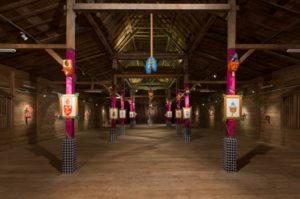
View of “IdeTriBali”, solo exhibition, Kayu, Bali, 2015. Courtesy of Kayu Lucie Fontaine. Photo: Evelyn Pritt.
The first Rebirth Forum: SUSTAINABILITY THROUGH DIFFERENCES & THE GREAT ARCHIPELAGO
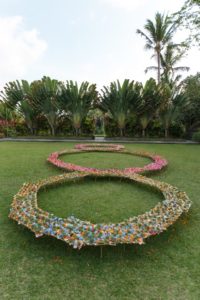
View of Third Paradise symbol, Kayu, Bali, 2018. Made by EVA NATASA STUDIO. Courtesy of Kayu Lucie Fontaine. Photo: Evelyn Pritt.
In 2017, I was invited by Italian Institute of Culture (IIC) in Jakarta to organize the first Rebirth Forum of the Third Paradise in the South-East Asia in collaboration with Italian Embassy, IIC Jakarta and Cittadellarte. Unanimously we agreed to include the Forum in Kayu Lucie Fontaine art programme in Setia Darma The House of Masks and Puppets, Bali. The environment and the culture that surround the Kayu programme were in the perfect harmony with Michelangelo Pistoletto’s philosophy of the Third Paradise, in which art becomes symbol to raise awareness in the community for a common virtuous practice and a return to a dialogue with nature.
In fact, Bali is an example of how art through religious practice is integrated into all aspects of Balinese social life. In particular in Bali, art is a daily practice of the polis, aesthetically useful for giving thanks to the gods and to the nature.
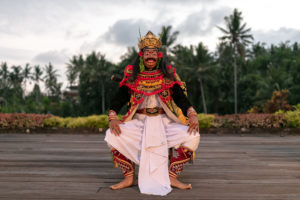
View of Balinese traditional performance, Kayu, Bali, 2018. Courtesy of Kayu Lucie Fontaine. Photo: Cyril Saulnier.
In addition of this, the programme conceived by Kayu in relation to the traditional environment reflects upon the concept of the dichotomy past / present, a concept dear to Michelangelo Pistoletto, and at the same time a feature of Balinese society.
The dialogue between past and present, tradition and contemporary became one of the strategies conceived by the Forum to infuse the Third Paradise principles into local community.
Entitled “Sustainability Through Differences”, the first Rebirth Forum was a three-day event in December 2018, which accommodated around fifty people selected for their expertise and activities in the local area of Bali.
The title referred to the Indonesian concept ‘Bhinneka Tunggal Ika’ (United in the Differences), in which the complex ecosystem of the country finds its balance**.
The participants in the Forum were divided in five round tables talks and were invited to discuss and share their activities carried out in the territory (Indonesia) on different themes inspired by the Sustainable Development Goals (SDGs).
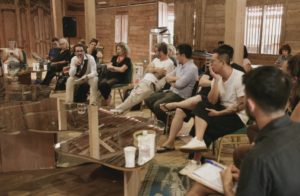
View of “Sustainability Though Differences”, first Rebirth Forum, Kayu, Bali, 2018. Courtesy of Kayu Lucie Fontaine. Photo: Evelyn Pritt.
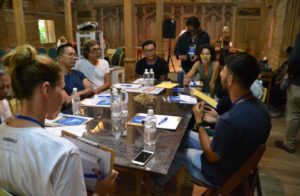

View of “Sustainability Though Differences”, first Rebirth Forum, Kayu, Bali, 2018. Courtesy of Cittadellarte. Photo: Marina Maffei.
The Forum went with “The Great Archipelago”, an international group exhibition including contributions by Arahmaiani, Ashley Bickerton, Dora Budor, Marco Cassani, Rafram Chaddad + Rirkrit Tiravanija, Fendry Ekel, Michal Helfman, Michelangelo Pistoletto, Rochelle Goldberg, Filippo Sciascia and Entang Wiharso.
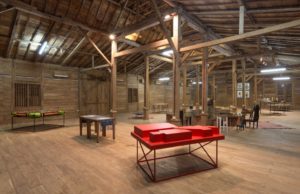
View of “The Great Archipelago”, a group exhibition, Kayu, Bali, 2018. Courtesy of Kayu Lucie Fontaine. Photo: Evelyn Pritt.
The exhibition conceived by Kayu was deeply inspired by the work of Michelangelo Pistoletto and reflected on the concept of the table as a domestic object and as a symbol of union. The exhibition featured eleven tables designed by the aforementioned artists and produced in Indonesia. The tables exhibited hosted the participants in the Forum during the event. After the conclusion of the Forum all the tables remained on view for the entire duration of the exhibition.

View of “The Great Archipelago”, a group exhibition, Kayu, Bali, 2018. Courtesy of Kayu Lucie Fontaine. Photo: Cyril Saulnier.
Furthermore, the title of the exhibition referred to the title of Michelangelo Pistoletto’s artwork “Il Grande Arcipelago” [The Great Archipelago], a mirror table conceived by the artist for that occasion and produced in Indonesia and twelve chairs. The table represented the seas that touch Indonesia and it was part of the mirror table series that Pistoletto made and which looked at the sea as the ultimate cultural melting pot, a symbol of meeting between different cultures. The chairs came from twelve different regions and cities of Indonesia and represent the multiculture of the country.
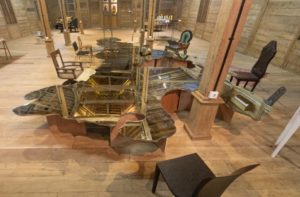
Michelangelo Pistoletto, “Il Grande Arcipelago”, 2018. Courtesy of the artist and Kayu Lucie Fontaine. Photo: Evelyn Pritt.
The Forum grew organically over the three days, showing the different perspectives that the participants offered on the various topics of the Forum. In particular, one of the round tables talks analysed cultural traditions as a vehicle for infusing the Third Paradise values inside local community. Starting from this point, I initiated to create an art space called BATU, dedicated to topics emerging from the Forum.
Batu Art Space
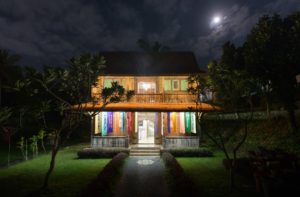
View of Batu Art Space, Bali, 2019. Courtesy of Kayu Lucie Fontaine and Batu Art Space. Photo: Evelyn Pritt.
Batu, which means ‘stone’ in Indonesian and Balinese languages, is located in a two-storey Limasan (traditional Javanese house) at Setia Darma The House of Masks and Puppets and its artistic and research programmes are conceived by me and my colleague Bali/Berlin based artist Fendry Ekel, who had participated in the Forum and in the group exhibition as one of the facilitators and as one of the artists. In addition of this, Ekel also participated in the residency programme of Cittadellarte, Biella, Italy, in 1999. The foundation of Batu as an art institution is its art collection, which is semi permanently displayed in the art space. The art collection is belong to Kayu Lucie Fontaine initiative.
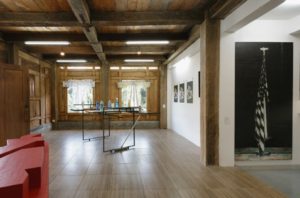
View of Batu Art Space, Bali, 2019. Courtesy of Kayu Lucie Fontaine and Batu Art Space. Photo: Evelyn Pritt.
The soft opening of Batu Art Space on the 11th May 2019 marked its mission: on one hand, Batu Art Space wants to share the knowledge of contemporary art with the local community in Bali; the art space displays semi-permanently a collection (ongoing) of artworks by international and local artists who participated in the Kayu programme. Most of the artworks were exclusively produced for the Kayu art programme in Indonesia in collaboration with local artisans and with companies based in Bali.
The artists in the collection are: Ashley Bickerton, Dora Budor, Marco Cassani, Radu Comsa, Patrizio Di Massimo, Fendry Ekel, Anthea Hamilton, Maria Hassabi, Michal Helfman, Agnieszka Kurant, Corrado Levi, Matteo Rubbi, Alice Tomaselli and Alexandra Zuckerman.
On the other hand, il Batu wants to create a series of initiatives, hosted by Kayu in cooperation with other partners, which aim is to reflect upon social and environmental issues; the presentation of Arahmaiani’s performance The Flag Project, at Kayu, marked this aspect.
Arahmaiani, who was one of the participants of the Forum, is one of Indonesia’s most seminal and respected contemporary artists. She has long been internationally recognized for her powerful and provocative commentaries on social, political and cultural issues. Born in 1961 in Bandung, Indonesia, she established herself in the 1980s as a pioneer in the field of performance art in Southeast Asia, although her practice also incorporates a wide variety of media. For the past six years, a particular focus of her work has been the environmental issues of the Tibetan plateau region, where she has been actively collaborating on-site with Buddhist monks and villagers to foster greater environmental consciousness through an array of ongoing community projects.
The Flag Project
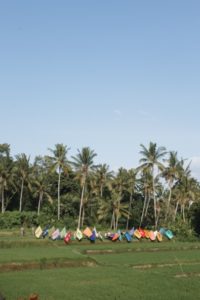
Arahmaiani, “The Flag Project”, Kayu, Bali, 2019. Courtesy of the artist and Kayu Lucie Fontaine. Photo: Evelyn Pritt.
Rooted in actions that are community based, “The Flag Project” (2006 – ongoing) sees the artist engaging with members of various communities in order to manifest their concerns, thoughts and hopes, which she materializes in the form of texts sewn on flags. Initially started by Arahmaiani with Amumarta Pesantren (an Islamic boarding school) after a major earthquake hit Yogyakarta in 2006, the project has gone through several implementations in various communities in Indonesia, Australia, Malaysia, Singapore, Thailand, Philippines, Japan, China, Tibet, Germany and Belgium.
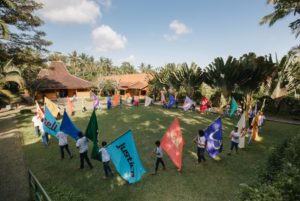
Arahmaiani, “The Flag Project”, Kayu, Bali, 2019. Courtesy of the artist and Kayu Lucie Fontaine. Photo: Evelyn Pritt.
At Kayu Arahmaiani’s performance involved around thirty people, her friends from the community of artists in Bali. Holding thirty flags, the participants presented a parade inside The House of Masks and Puppets complex; afterwards, the flags were displayed at Batu until the end of the project.
The performance and the flags are the result of collaborative work. The artist creates an “open art system” based on democratic tools through which the community identifies solutions to the issues that are considered relevant or crucial. During the process, Arahmaiani positions herself as the facilitator, mediating the discussion and allowing the communities to organically express their thoughts in the form of collective, collaborative and individual works. This system creates a sustainable network of communities.
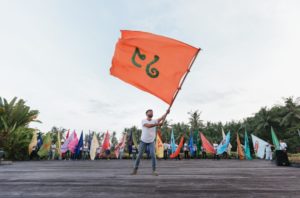
Arahmaiani, “The Flag Project”, Kayu, Bali, 2019. Courtesy of the artist and Kayu Lucie Fontaine. Photo: Evelyn Pritt.
The colourful handmade flags contain the core values of the various faith and cultural communities Arahmaiani has cooperated with over the years. The notions emerged are presented in key words which are sewn in various languages on the flags. The key words included are: Freedom, Love, Heart, Courage, Mind, Culture, Capital, Earth, Water, Air, Food, Resistance, Wisdom, Happiness, Hand in Hand and Solidarity, and also short phrases such as “Don’t be arrogant”. The flags were made by a group of seamstresses in a village near Yogyakarta, on the island of Java, Indonesia.
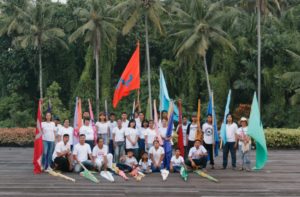
Arahmaiani, “The Flag Project”, Kayu, Bali, 2019. Courtesy of the artist and Kayu Lucie Fontaine. Photo: Evelyn Pritt.
Arahmaiani’s performance at Kayu is the culmination of a dialogue the artist started with the Balinese community in the Bona village 30 years ago and “these flags serve as a statement for respecting cultural diversity and faiths” ***.
Batu Art Space is open by appointment only and located at Setia Darma The House of Masks and Puppets in Bali. For further information please contact: info@batuartspace.org or visit www.batuartspace.org
Batu Art Space inaguration opening is on December 7th, 2019.

